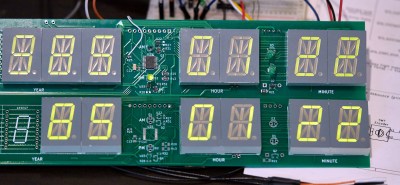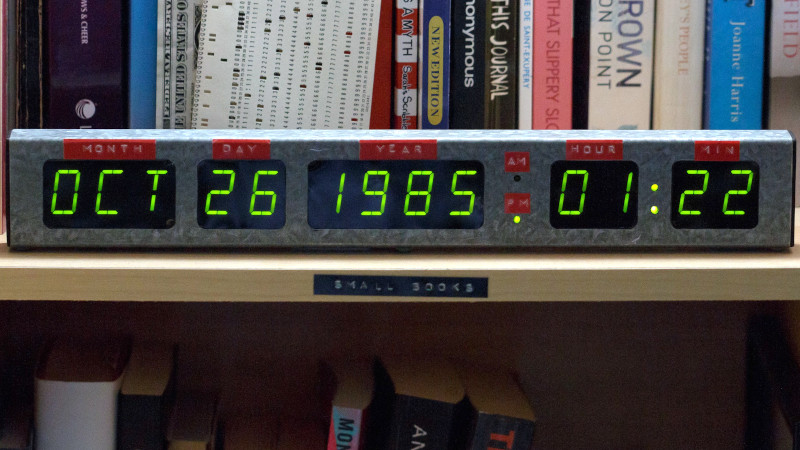[Stephen Holdaway] needed a desk clock, and decided to whip something up from scratch. The result is a beautiful tribute to the DeLorean’s time circuits from legendary 1985 film Back to the Future.
We say it’s a tribute rather than an exact replica, as it only implements the “present time” section of the time circuits. However, for those of us without time machines, that’s more than enough. In any case, the build is a very faithful recreation. It uses a lovely sheet metal enclosure complete with era-appropriate sticky labels.
 Naturally, the numerals are all shown on green segment displays, though [Stephen] used 16-segment devices instead of the more typical 7-segment parts. What really helps add to the look is the shaded acrylic windows, which adds a very nice effect.
Naturally, the numerals are all shown on green segment displays, though [Stephen] used 16-segment devices instead of the more typical 7-segment parts. What really helps add to the look is the shaded acrylic windows, which adds a very nice effect.
It’s a nice tribute piece that any fan would instantly recognize. We’ve seen some other great builds, too, like this replica of the RC controller that first gets the DeLorean up to 88 mph. If you’ve been whipping up your own neat prop project, don’t hesitate to hit us up on the tipsline!
















Nice result, and on a project timescale I can get behind.
I 😍 that Korwin-Mikke book behind the clock. A man of culture and eloquency I see.
where?
trouble with this and similar project are POWER.
I hate wire
Fantastic project log; that Holtek HT16K33 deadbugging is quite nicely done!
Documenting everything that didn’t work is also much appreciated.
I really, really like it, but regardless of what the movie prop had, it needs the seconds count.
> era-appropriate sticky labels
Isn’t that just dymo labels though? That would be “era-appropriate” from 1958 to… pretty much today.
Don’t where you are from, but we switched to electrical Dymo label makers decades ago. The look is different.
It’s a manual rotary Dymo label maker circa 80’s.
Came with different color dymo tapes.
I owned a couple. Non-electronic. Just press hard on the trigger to create embossing of each individual letters or numbers.
Hehe…
The original plastic tape is still for sale, as well as the manual and the electric punches.
It requires 4.1amps to run. Wut.
Yeah my estimate was a bit high there. The actual power draw with dual HT16K33’s and all segments lit is ~0.6 A, averaging ~250 mA showing the time, so it’s not too bad in practice. Segments are only lit 1/16th of the time at max brightness with these drivers.
I abused it for the Vintage MTB Festival:
http://www.vintagemtb.org/
http://vintagemtb.wdfiles.com/local–files/start/vintage-mtb-fest-cropped-600x.png
Did the IBM system pass its test?
From the looks of it, bribery was involved.
B^)
slightly off topic – but does anyone know of anything that can display very fast updating digits? My son is doing some video (about 1000fps), and we want something in the shot to measure the frame rate stability…
My first idea was to have a clock updating quickly ie every 10uS, but that rapidly turned into a bad idea when I saw how long the segment displays take to update..
Ideas welcome!
A dremel tool with a line marked onto the cutoff wheel. You may not know the dremel RPM but you could at least check frame rate stability.
I’m not sure it has a stable rotation speed…
A digital clock that does not display (at least) seconds, is not really a clock. Swing-and-a-miss [Stephen Holdaway].
After seeing this and already having a collection of bttf stuff and previously making my own flux capacitor, I immediately purchased a bunch of parts to make one of these for myself. Utilising the ht16k33 modules an esp32-s2 and an mp3 player module with the 16 seg displays. One of my easiest projects in a long time and looks amazing – why didn’t I make one sooner!
Yeah, it’s not movie accurate but its immediately identifiable by any fan of the trilogy.
As for the current, its no where near what he states is needed when using the ht16k33 chips. mine pulls 300ma all on. He calculates the power per led x segments x characters but they’re not on at the same time due to multiplexing.
Nice one! Yeah I didn’t factor the duty cycle into that, so it was way off. With all segments running on the HT16K33s it maxes out about 600 mA